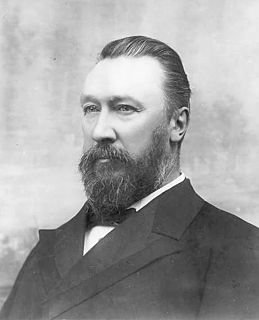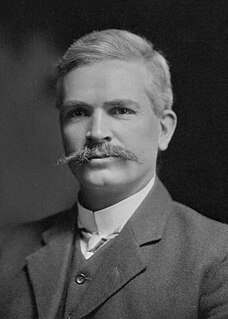
John Christian Watson, commonly known as Chris Watson, was an Australian politician who served as the third Prime Minister of Australia. He was the first Prime Minister from the Australian Labour Party, and led the world's first Labour Party government, indeed the world's first socialist or social democratic government, at a national level. From paternal German and maternal British ancestry, he is the only Australian Prime Minister not born in a Commonwealth country.

Sir George Houstoun Reid was an Australian politician who led the Reid Government as the fourth Prime Minister of Australia from 1904 to 1905, having previously been Premier of New South Wales from 1894 to 1899. He led the Free Trade Party from 1891 to 1908.
The Free Trade Party which was officially known as the Australian Free Trade and Liberal Association, also referred to as the Revenue Tariff Party in some states, was an Australian political party, formally organised in 1887 in New South Wales, in time for the 1887 colony election, which the party won. It advocated the abolition of protectionism, especially protective tariffs and other restrictions on trade, arguing that this would create greater prosperity for all. However, many members also advocated use of minimal tariffs for government revenue purposes only. Its most prominent leader was George Reid, who led the Reid Government as the fourth Prime Minister of Australia (1904-5). In New South Wales it was succeeded by the Liberal and Reform Association in 1902, and federally by the Anti-Socialist Party in 1906. In 1909, the Anti-Socialist Party merged with the Protectionist Party to form the Commonwealth Liberal Party.
The Protectionist Party was an Australian political party, formally organised from 1887 until 1909, with policies centred on protectionism. It advocated protective tariffs, arguing it would allow Australian industry to grow and provide employment. It had its greatest strength in Victoria and in the rural areas of New South Wales. Its most prominent leaders were Sir Edmund Barton and Alfred Deakin, who were the first and second prime ministers of Australia.
The Commonwealth Liberal Party was a political movement active in Australia from 1909 to 1917, shortly after Federation. The CLP came about as a result of a merger between the two non-Labor parties, the Protectionist Party and the Anti-Socialist Party which most of their MPs accepted. The CLP is the earliest direct ancestor of the current Liberal Party of Australia.

Sir William John Lyne KCMG was an Australian politician who served as Premier of New South Wales from 1899 to 1901, and later as a federal cabinet minister under Edmund Barton and Alfred Deakin. He is best known as the subject of the "Hopetoun Blunder", unexpectedly being asked to serve as the first Prime Minister of Australia but failing to form a government.
This is a list of the members of the Australian House of Representatives in the Second Australian Parliament, which was elected on 16 December 1903.

Federal elections for the inaugural Parliament of Australia were held in Australia on Friday 29 March and Saturday 30 March 1901. The elections followed Federation and the establishment of the Commonwealth of Australia on 1 January 1901. All 75 seats in the Australian House of Representatives, six of which were uncontested, as well as all 36 seats in the Australian Senate, were up for election.
This is a list of the members of the Australian Senate in the First Australian Parliament, which was elected on 29 March 1901. There were 36 senators in this initial parliament. Terms were deemed to start on 1 January 1901. In accordance with section 13 of the Constitution, the Senate resolved that in each State the three senators who received the most votes would sit for a six-year term, finishing on 31 December 1906 while the other half would sit for a three-year term, finishing on 31 December 1903. The process for filing of casual vacancies was complex, with an initial appointment followed by an election. The status of political parties varied, being national, State based, and informal.
Federal elections were held in Australia on 12 December 1906. All 75 seats in the House of Representatives, and 18 of the 36 seats in the Senate were up for election. The incumbent Protectionist Party minority government led by Prime Minister Alfred Deakin retained government, despite winning the fewest House of Representatives votes and seats of the three parties. Parliamentary support was provided by the Labour Party led by Chris Watson, while the Anti-Socialist Party, led by George Reid, remained in opposition.

Federal elections were held in Australia on 13 April 1910. All 75 seats in the House of Representatives, and 18 of the 36 seats in the Senate were up for election. The incumbent Commonwealth Liberal Party led by Prime Minister Alfred Deakin was defeated by the opposition Labour Party, led by Andrew Fisher.
This article provides information on candidates who stood for the 1901 Australian federal election. The election was held on 29/30 March 1901.
This article provides information on candidates who stood for the 1903 Australian federal election. The election was held on 16 December 1903.
This article provides information on candidates who stood for the 1906 Australian federal election. The election was held on 12 December 1906.
This is a list of members of the Australian Senate from 1907 to 1910. Half of its members were elected at the 16 December 1903 election and had terms starting on 1 January 1904 and finishing on 30 June 1910; the other half were elected at the 12 December 1906 election and had terms starting on 1 January 1907 and finishing on 30 June 1913. They had an extended term as a result of the 1906 referendum, which changed Senate terms to finish on 30 June, rather than 31 December.
This is a list of members of the Australian Senate from 1904 to 1906. Half of its members were elected at the March 1901 election and had terms deemed to start on 1 January 1901 and finishing on 31 December 1906; the other half were elected at the 16 December 1903 election and had terms starting on 1 January 1904 and finishing on 30 June 1910, extended as a result of the 1906 referendum, which changed Senate terms to finish on 30 June, rather than 31 December. Parties reflect those acknowledged at the time of the 1904 election

The Barton Government was the first federal Executive Government of the Commonwealth of Australia. It was led by Prime Minister Sir Edmund Barton, from 1 January 1901 until 24 September 1903, when Barton resigned to become one of the three founding judges of the High Court of Australia.
The history of the Australian Labor Party has its origins in the Labour parties founded in the 1890s in the Australian colonies prior to federation. Labor tradition ascribes the founding of Queensland Labour to a meeting of striking pastoral workers under a ghost gum tree in Barcaldine, Queensland in 1891. The Balmain, New South Wales branch of the party claims to be the oldest in Australia. Labour as a parliamentary party dates from 1891 in New South Wales and South Australia, 1893 in Queensland, and later in the other colonies.

The Watson Government was the third federal executive government of the Commonwealth of Australia. It was led by Prime Minister Chris Watson of the Australian Labor Party from 27 April 1904 to 18 August 1904. The Watson Government was the first Labor Party national government in both Australia and in the world. Watson was aged just 37 when he became Prime Minister of Australia, and remains the youngest person to have held the post.

The Reid Government refers to the period of federal executive government of Australia led by Prime Minister George Reid. It lasted from 18 August 1904 - 5 July 1905. Reid was the one and only Prime Minister of Australia to belong to the Free Trade Party. Allan McLean of the Protectionist Party served as deputy.




















